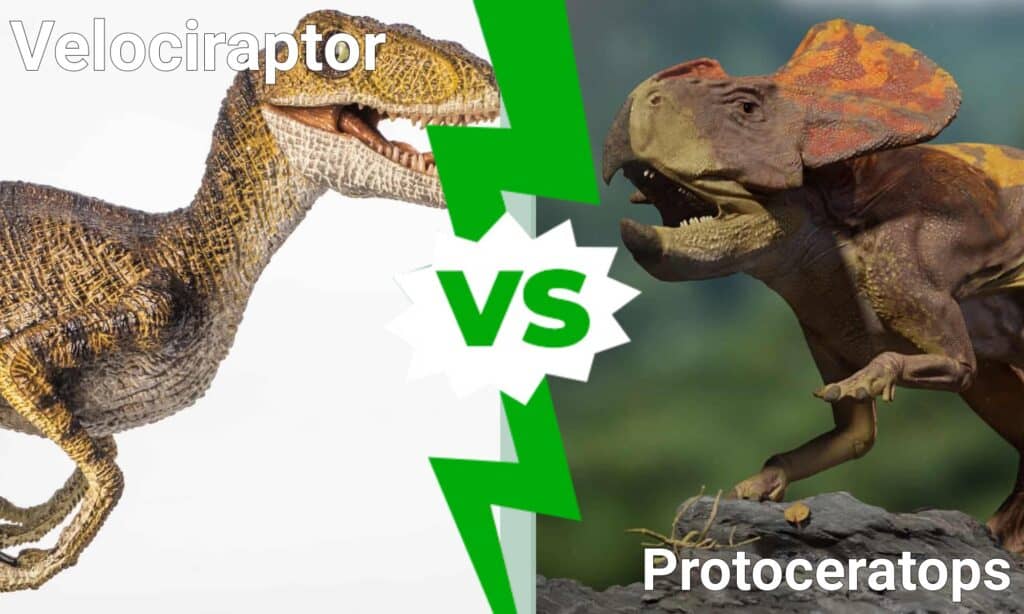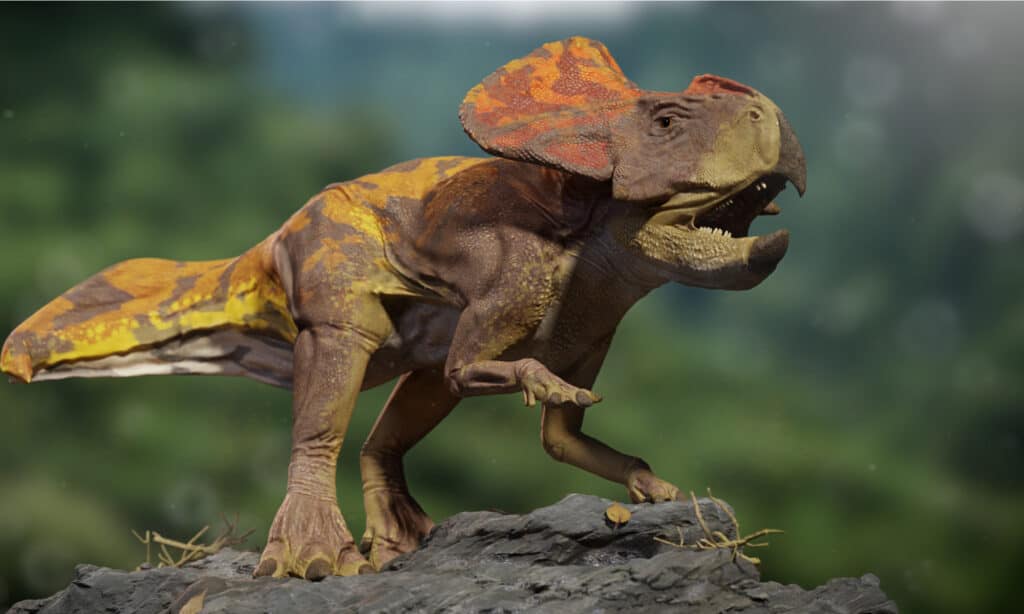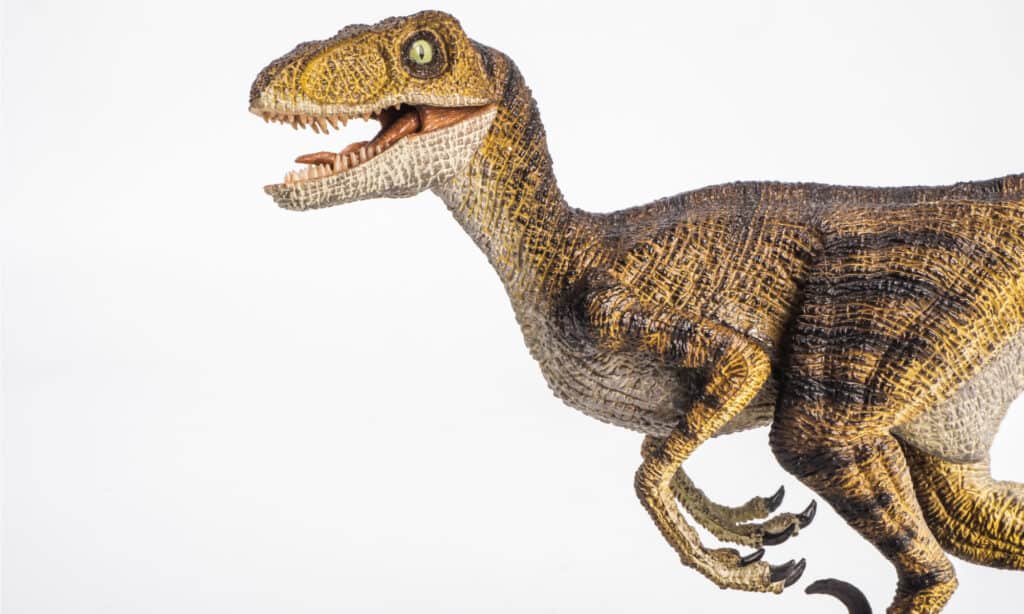Dinosaurs varied a great deal in terms of their size and strength throughout their long reign. Scientists can even track the evolution of some dinosaurs over time based on their fossil records. For example, they know that the Protoceratops is an ancestor of the horned triceratops. Protoceratops lacked horns, making them a fairer match for smaller carnivorous dinosaurs, like Velociraptors. How are these dinosaurs different, and who would win a Velociraptor vs Protoceratops fight? We’ll show you by breaking down each animal’s advantages against the other.
Comparing a Velociraptor and a Protoceratops

| Velociraptor | Protoceratops | |
|---|---|---|
| Size | Weight: 20lbs-33lbs, perhaps up to 50lbs. Height: 1.5-2.5ft tall overall Length: 4.5ft-6.5ft | Weight: 52lbs-182lbs, up to 400lbs Height: 2ft at shoulder, 3ft overall Length: 5ft-5.9ft |
| Speed and Movement Type | – 10-24 mph – Bipedal striding | – 10 mph (estimate based on short legs and relatively weak forelegs) |
| Defenses | – Speed – Agility | – Heavy body – Frill on the back of the neck like Triceratops |
| Offensive Capabilities | – 3-inch claw on the second toe of each foot – A swift, agile attacker that could stay balanced while attacking prey with its feet – 28 teeth serrated on the back edge – Attacked by leaping at and pinning prey, finishing them shortly after | – Large beak-like mouth that could bite – Powerful jaws could be used against others – Could pin animals with its body and stomp them. |
| Predatory Behavior | – Hunted alone rather than in packs as portrayed in the films – Attempted to cut its prey’s neck – Nocturnal hunter | – Herbivore that didn’t hunt other creatures |
What Are Key Differences Between a Velociraptor and a Protoceratops?

Protoceratops was similar to a triceratops without horns.
©Dotted Yeti/Shutterstock.com
The biggest differences between a Velociraptor and a Protoceratops include their size and morphology. Velociraptor was a feathered bipedal theropod that weighed 30lbs and stood about 2.5ft tall, but the protoceratops was a quadrupedal ceratopsian dinosaur that weighed about 182lbs fully grown and stood about 3ft high.
This information is helpful to our discussion of which reptile would win in a fight, but it’s not enough to declare a winner. We’ll take a much closer look at the two dinosaurs and their various elements to make our final determination.
What Are the Key Factors in a Fight Between a Velociraptor and a Protoceratops?
The most important factors in a Velociraptor vs Protoceratops fight are size, speed, and offensive capabilities. These are common elements across many fights between two animals. These factors are especially important here because of the size difference between these dinosaurs. Overcoming such a huge disparity is difficult, but not impossible.
Velociraptor vs Protoceratops: Size
Protoceratops was larger than Velociraptor. The Protoceratops weighed between 52lbs and 182lbs or possibly up to 400lbs, stood 3ft tall, and measured about 5.9ft long. However, the Velociraptor was only about 33lbs or perhaps 50lbs, stood between 1.5ft and 2.5ft overall, and grew 6.5ft long.
Protoceratops had the size advantage in this fight.
Velociraptor vs Protoceratops: Speed and Movement
Velociraptor was faster than Protoceratops. The Velociraptor wasn’t incredibly fast, but it could still run at speeds of between 10 and 24 mph. Protoceratops had short legs and relatively weak forelegs. As a result, it probably only managed to run at about 10 mph, but that is only an estimate based on comments from scientists.
Velociraptors had the speed advantage.
Velociraptor vs Protoceratops: Defenses
Velociraptors relied on their speed and agility to keep them safe from other dinosaurs. Aside from that, it didn’t have much in the way of defense.
Protoceratops had powerful defenses in the form of their massive size and the frill on the back of their necks. Like triceratops in the future, the frill on the Protoceratops’ neck would protect it from bites and attacks in some cases. This bony outcropping could absorb a fair amount of damage.
Protoceratops had the defensive advantage.
Velociraptor vs Protoceratops: Offensive Capabilities
Despite being an herbivore, the Protoceratops had some offensive capabilities. For one thing, it could use its weight to thrash about and strike enemies. They could pin attackers, stomp on them, and potentially ram them. Also, they had large, beak-like mouths that could deliver a powerful bite. Although it was meant for plant matter, it could also work as a defense.
Velociraptor was known for its 3-inch claw on the second toe of each foot. These sickle-shaped claws could cut deeply into prey, allowing Velociraptors to inflict terrible wounds on prey. This dinosaur would leap at prey to gash them open, usually while holding it with its front claws. They also had serrated teeth to help them finish off prey.
Velociraptors had the advantage in offensive powers.
Velociraptor vs Protoceratops: Predatory Behavior
The Protoceratops was not a predator, so it did not have any predatory behaviors. However, Velociraptor was a lone hunter that used ambushes or opportunistic predation to find and kill its prey. When it did locate prey, Velociraptor would use its long claws to dig into the neck of its prey. Most of the time, it hunted at night.
Velociraptors had the advantage in predatory behavior.
Who Would Win in a Fight Between a Velociraptor and a Protoceratops?

Velociraptor was small yet very strong.
©kamomeen/Shutterstock.com
Velociraptor would win a fight against a Protoceratops. In fact, fossil records showed that a Velociraptor had used its long claws to dig into the neck of a Protoceratops before both were killed by a collapsing sand dune. Other records demonstrated that Velociraptors actively preyed on Protoceratops.
That same attack method is what Velociraptor would use to win the fight every time. They would use their speed to get close to the Protoceratops and attack the neck. The speed and agility of the Velociraptor would be the only thing keeping the smaller dinosaur alive.
The overwhelming attacks on the neck and sides of the larger dinosaur could cause it to bleed out. However, if the Velociraptor made a mistake and got caught by the powerful beak-like mouth of the Protoceratops, the fight could be over. Breaking the Velociraptor’s leg or arm, or biting its side would be devastating at the least or potentially fatal in the worst case.
However, the slow-moving herbivore would have its work cut out for it since the Velociraptor could strike just once, cut its jugular vein, and end the battle.
The photo featured at the top of this post is © kamomeen/Shutterstock.com
Thank you for reading! Have some feedback for us? Contact the AZ Animals editorial team.







